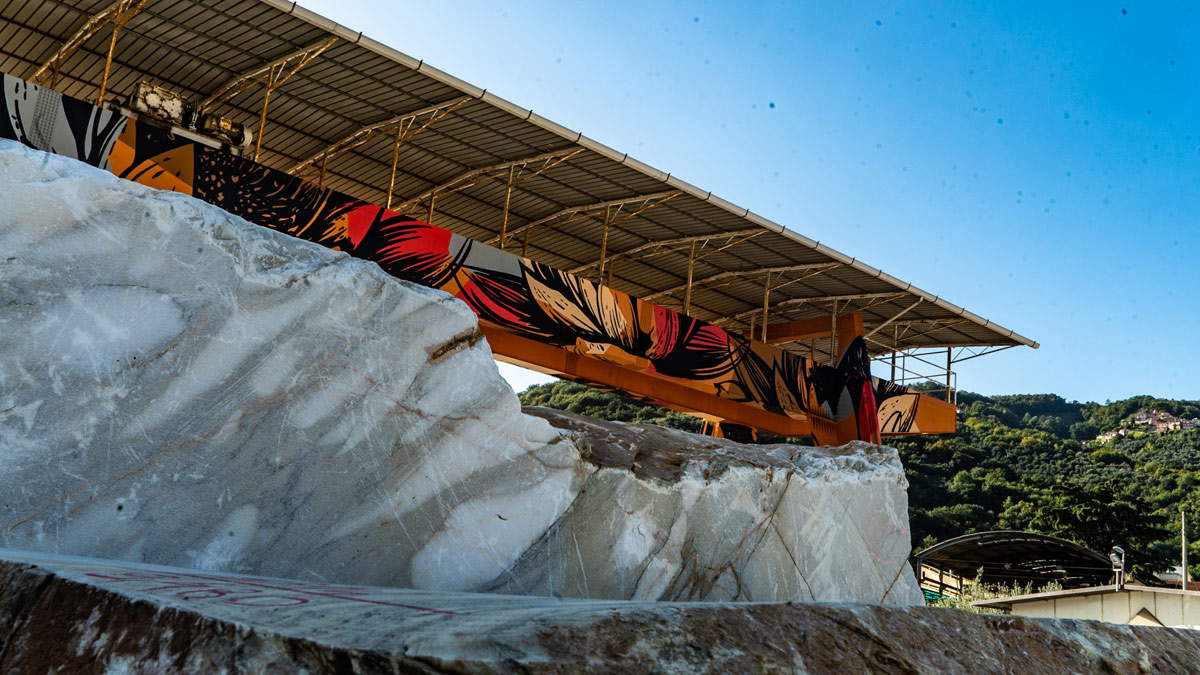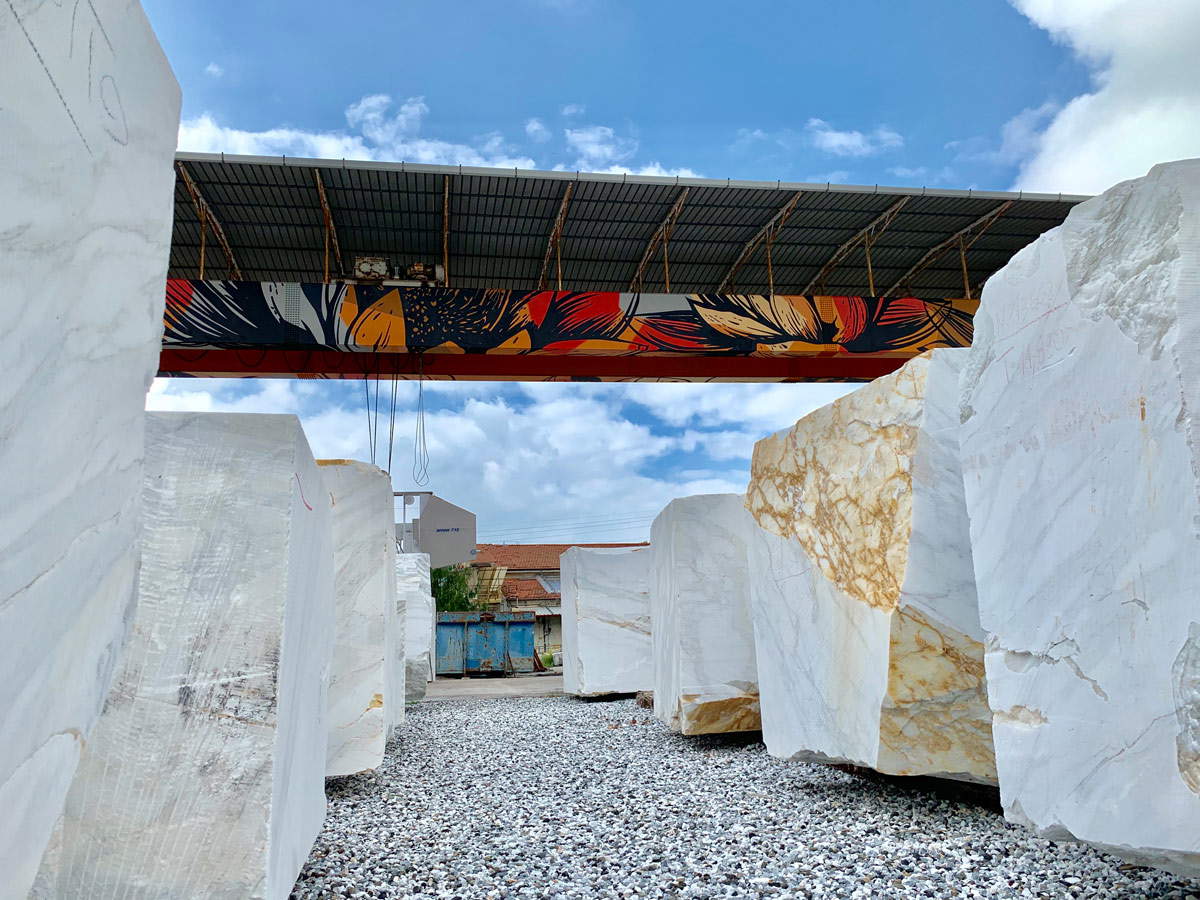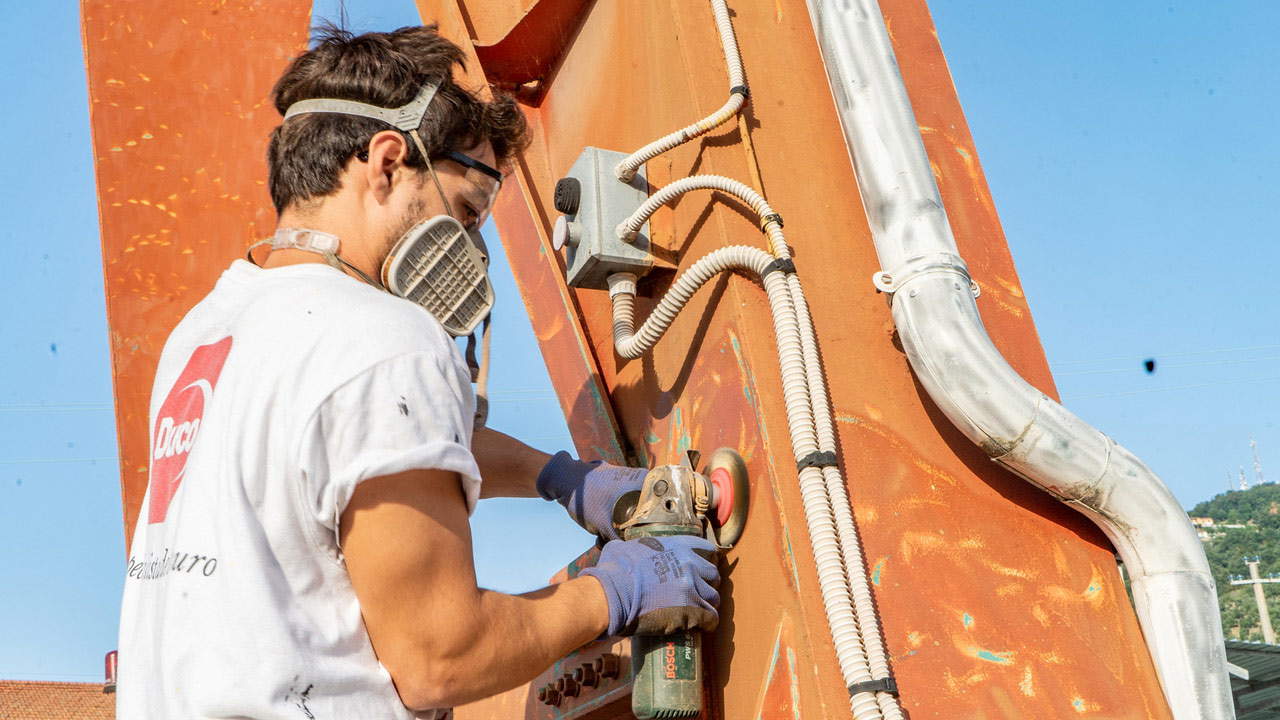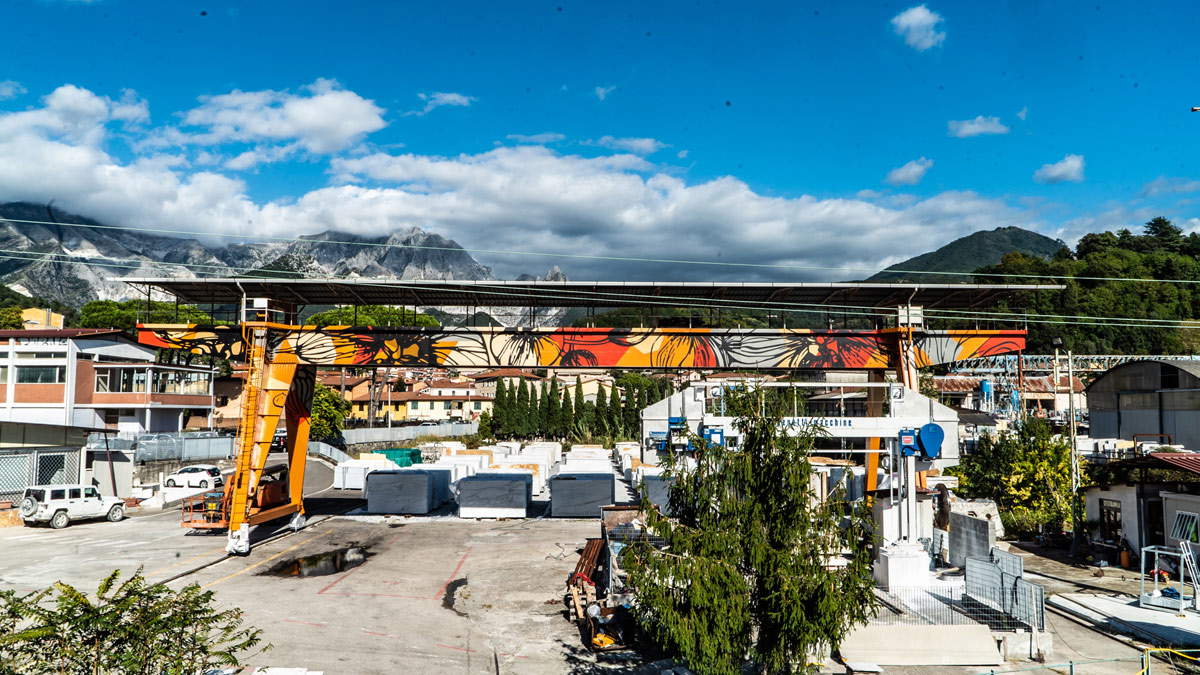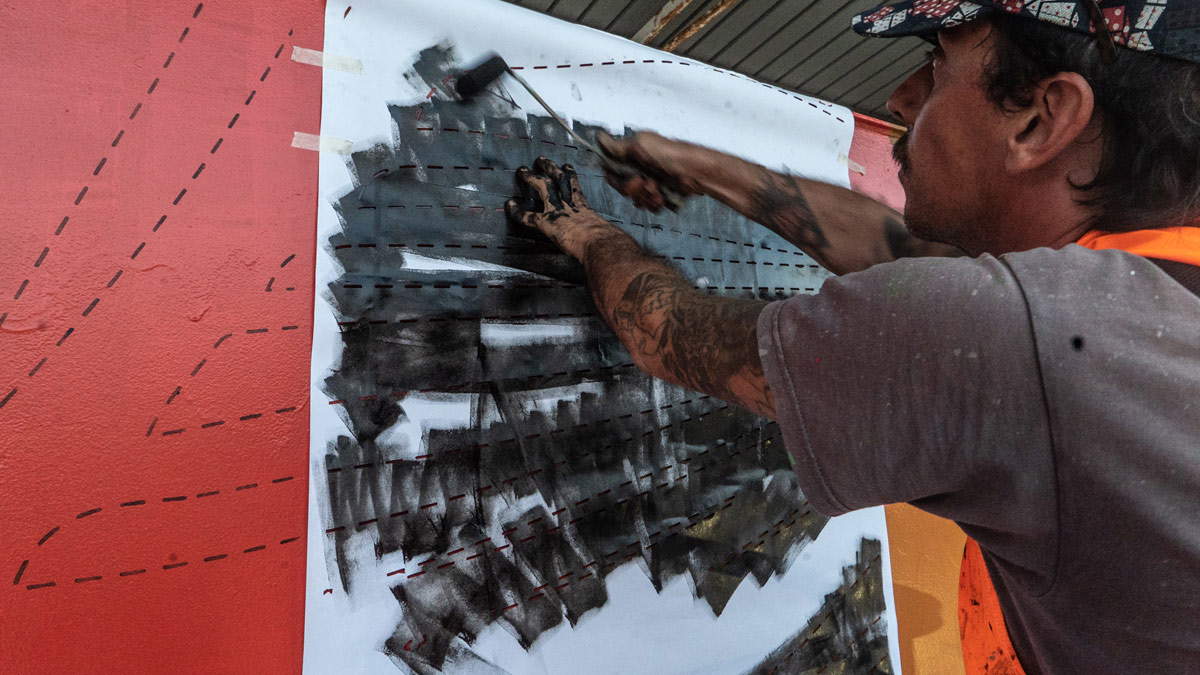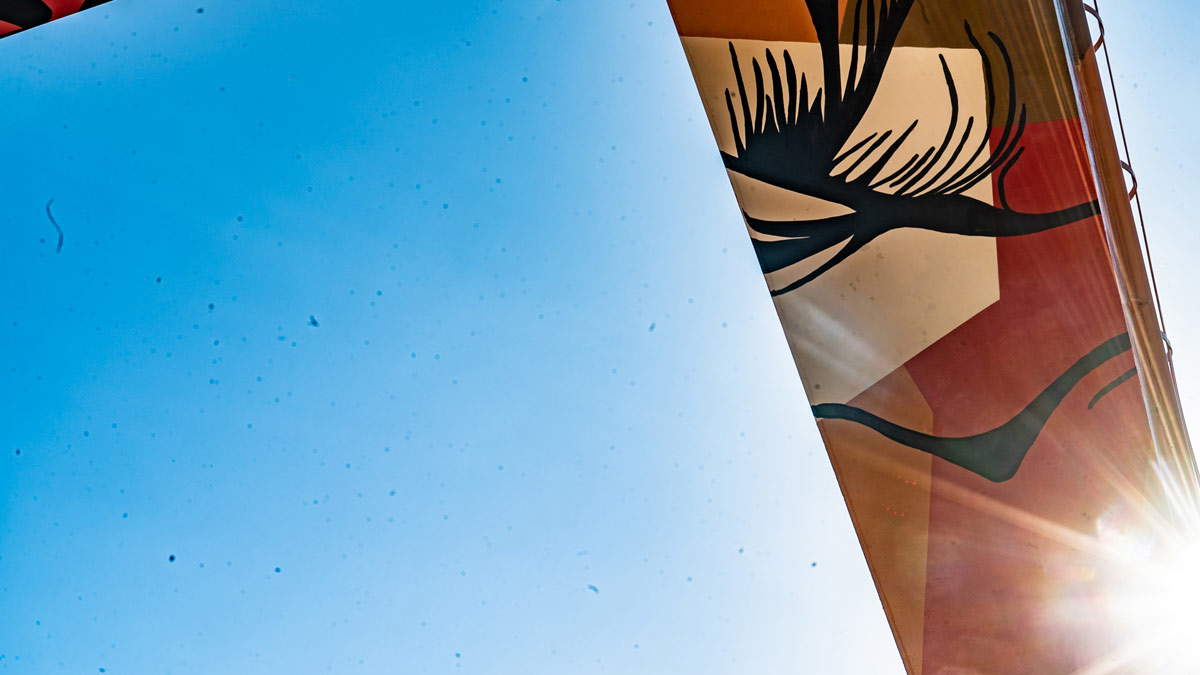by Redazione , published on 01/10/2019
Categories: Art and artists
/ Disclaimer
In Carrara, the Orticanoodles collective creates 'Natural Beauty,' a street art intervention on the overhead crane of a marble company.
As of today, in Carrara, the workers of the Calacata Borghini company, one of the Apuan marble giants, can say that they work “in beauty”: in fact, the company, in order to celebrate its 40th anniversary, wanted to create a public art intervention in its spaces, and therefore called several internationally renowned Italian street artists to try their hand at the theme of beauty and nature. In the end, the sketch of the art collective Orticanoodles was chosen: the work, entitled Natural Beauty, was executed on the surface of an overhead crane, a large piece of machinery used to move marble blocks. It is one of the rare Italian street art interventions made in a working working environment.
“The will of the company,” reads a note from Calacata Borghini, “was to promote an artistic initiative, declined in a form of contemporary and public art, to communicate a message of beauty and decorate the workplace, through the symbolism conceived by the artists with an artistic intervention specifically wanted on an industrial element strongly identifying the local reality.” Not only that: we learn from company sources that the company’s specific intention was not only to support art and give an artist (or a group of artists) the opportunity to perform an intervention of public significance, but also to create a work whose message would be addressed to all and usable by all. There is also a desire to conduct an operation of overwriting the urban-industrial landscape with a work that brings observers back to nature and its beauty. Thus, from today it will be possible to see a work of street art in motion in an industrial area, and given the size of the overhead crane, passersby will also be able to observe it from the street.
The work of Orticanoodles appropriates the machinery and the working environment through colors and signs that are meant to celebrate natural beauty, its uniqueness in imperfection, and the power of regeneration, while not nullifying the industrial function of the overhead crane (but rather emphasizing it with the choice of colors). It is therefore not, the creators of the project make known, a simple decoration, but a “gesture of senseless beauty” (as the artists define it) in the midst of an industrial context, a story of sign and color told by the machinery in motion among the white marble blocks.
Orange was chosen as the base color for two reasons: because of its implications in the world of industry (it is a high-visibility color and is the one chosen, therefore, for various industrial equipment) and because of its symbolism (it is given by the union of red and yellow and, in chromology, expresses wisdom, ambition, luxury and balance, since it represents at the same time the rising and setting of the sun and is commonly associated with the concept of birth, beginning, growth, the natural flow of energy and its balance). Other characteristic elements of the work are the lotus flower, a sacred flower for Hindus and Buddhists, a symbol of purity (in fact, the structure of its leaves allows it to remain clean even in muddy waters), femininity, prosperity, eternity and flow of positive energies (it was also a symbol of rebirth and reincarnation for the ancient Egyptians), and the orchid flower, synonymous with refinement, luxury, elegance and sensuality but also strangeness, uniqueness and eccentricity (because of its shape and scent). In addition, the orchid in ancient times was also a symbol of virility, by virtue of its shape, but also of its strength: in fact, the orchid is a plant that can withstand very different climates and environments. Moreover, orchids are an endemic species of the Apuan Alps.
“That of Orticanoodles for Calacata Borghini,” wrote art critic Alessandro Romanini in the text accompanying the project, "is an original operation that brings together the centuries-old tradition of marble and its working, the classical heritage of the precious material with the iconography of contemporary art. A relevant element of this intervention is the ’Olivettian’ nature of the operation, which sees a company from the Carrara area responding to the call of social responsibility, using art (by which the area has been characterized for centuries) to redeem a purely functional mechanical element and reconvert it into an aesthetic device that ennobles the skyline and reactivates social and relational dynamics. An operation reminiscent of that related to the ready-mades of the historical avant-gardes of the early 20th century, involving the removal of the pre-existing object from its everyday function (which in this case is retained), with displacement into the context of aesthetic contemplation (which is added to the instrumental-operational one). A creative operation consistent with Bauhaus theories, set on aesthetic regeneration and respect for functionality, on faith in the thaumaturgic value of art vis-à-vis one’s life."
From the point of view of the philosophy and technique that underpins Natural Beauty, the intervention by Orticanoodles, Romanini further states, "testifies to a strategy that the collective has honed over the course of its prestigious career. A strategy that brings together different disciplines, such as architecture and urbanism but also anthropology and sociology and of course chromatological and psychological notions, all embedded in site-specific dynamics and attention to environmental protection. From the beginnings characterized by stickering operations and the posting of posters they designed and produced, they have evolved into a creative form set on a pop codification, centered on the use of the stencil technique and the “stencil on stencil” concept, where portraits of iconic and mass-media personalities, are superimposed on the words of the lettering in order to create a synergy between subject and message. Carrara’s intervention represents the latest step in the maturation and awareness of [...] an Olivettian spirit of the creative collective. An attitude that leads the Orticanoodles to make collaboration with companies particularly sensitive to social responsibility, one of the main pillars of their operational strategy and poetics. Freed from any Luddite instances, conscious that only the interaction between the various components of the social and productive fabric, between creativity and the sensitivity of the productive dimension, in a meaning related to the vision that from Bauhaus comes to the present day, can produce tangible and effective results for the concerned territories. [...] For the intervention in Carrara, which takes its cue from the famous phrase of Prince Miskin from Dostoevsky’s The Idiot ’beauty will save the world,’ the execution was done through the ancient technique of dusting matrices. The quote is also a kind of manifesto that the artists and patrons shared and on which Calacata Borghini (through Marbo Srl) called them to reflect to elaborate the work."
In the photos below, the work and the artists of the Orticanoodles collective at work.
 |
| Natural Beauty by Orticanoodles for Calacata Borghini |
 |
| NaturalBeauty by Orticanoodles for Calacata Borghini |
 |
| NaturalBeauty by Orticanoodles for Calacata Borghini |
 |
| NaturalBeauty by Orticanoodles for Calacata Borghini |
 |
| NaturalBeauty by Orticanoodles for Calacata Borghini |
 |
| NaturalBeauty by Orticanoodles for Calacata Borghini |
 |
| NaturalBeauty by Orticanoodles for Calacata Borghini |
 |
| NaturalBeauty by Orticanoodles for Calacata Borghini |
 |
| NaturalBeauty by Orticanoodles for Calacata Borghini |
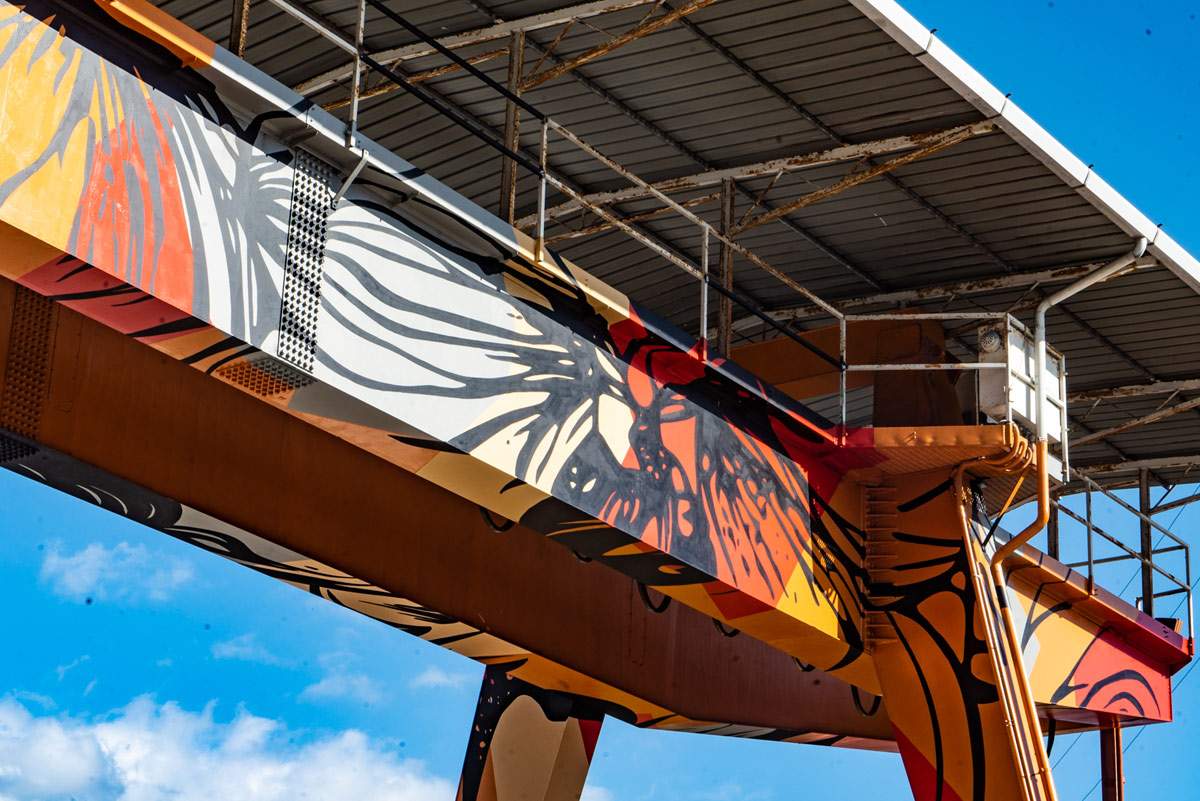 |
| A rare street art project in a workplace. In Carrara, Orticanoodles make workers work in the beautiful |
Warning: the translation into English of the original Italian article was created using automatic tools.
We undertake to review all articles, but we do not guarantee the total absence of inaccuracies in the translation due to the program. You can
find the original by clicking on the ITA button. If you find any mistake,please contact us.
